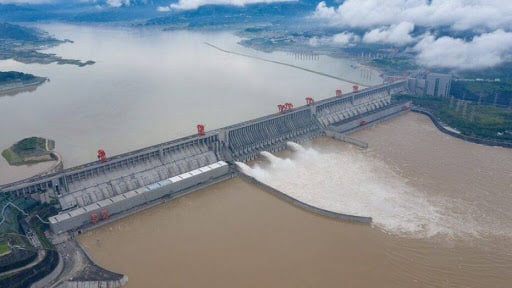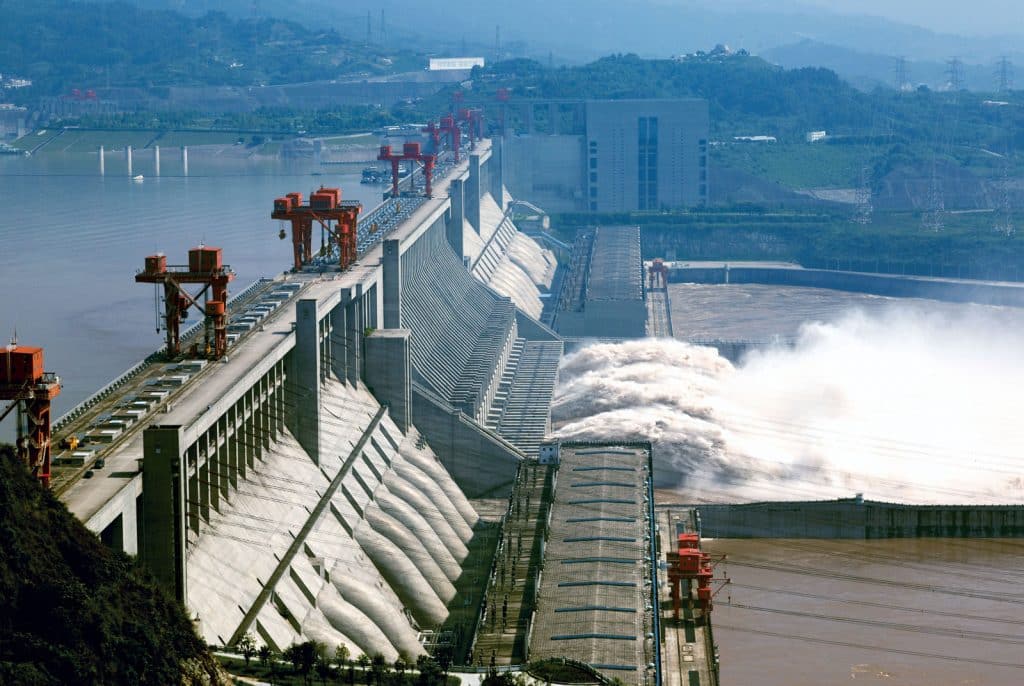Introduction
The Yangtze River, or “Child of the ocean” is the longest river in both China and Asia, as well as the third-longest river in the world. The river measures about 6,300 kilometers, with its glacial meltwaters extending from the Tanggula Mountains in Tibet to the East China Sea near the city of Shanghai, and flowing through the borders of 10 provinces (Pedersen, 2017).
The Yangtze River plays a crucial role in the country’s agricultural, industrial, and travel sectors, and is the country’s primary waterway. In the year 2006, the construction of the largest dam in the world in the Yangtze River was completed; The Three Gorges Dam. The implementation of this 25$ billion-dollar project was done to tackle the long-standing problem of the flooding of the river which had killed around 300,000 people in the last century (information sheet) and holds back an estimated 10.3 trillion gallons of water (Hays, 2011).
Although the dam plays an important role in different sectors of the country, it has had its share of criticism from around the world. As well as being the largest dam in the world, it is also the largest water controversy project in the world. The Three Gorges Dam impacts the environment and its inhabitants in both positive and negative ways – which is the topic that will be explored in this essay.
Positive Impacts of the Three Gorges Dam

The Three Gorges Dam was also built for power generation. Hydroelectric technology in the dam has a capacity of 22,500 megawatts of energy and is the most productive hydroelectric dam in the world (“Three Gorges Dam”, Britannica).
Hydroelectric dams generate electricity by holding water in its reservoir, and then releasing that water through the dam, spinning turbines which turn a metal shaft in the generator, and that produces electricity (“How Hydroelectric Power Works”, TVA).
This hydroelectric dam provides an annual 84.6 billion kilowatt-hours of clean energy through the use of 34 generators, each with a capacity of 700MW (“Three Gorges Dam”, Wikipedia), and supplies 10% of the country’s electricity requirements.
This is the equivalent of what 18 nuclear power plants would produce (Hays, 2011). The Three Gorges Dam also provides the country with a clean source of energy and decreases its carbon levels; To achieve the power output of The Three Gorges Dam, 31 million tons of coal would need to be burned per year – producing 80 million tons of CO2 (information sheet). The dam has also facilitated the shipment of agricultural and industrial goods across cities (Miller, 2015) – creating a 660-kilometer-long reservoir of calm, deep water, widening shipping lanes, and eliminating strong currents and obstacles such as rocks and sandbars.
Shipping costs from upstream of the dam to downstream of the dam have decreased by about 30% thanks to the dam (Gleick, 2009). Another benefit of the dam is that it has created 26,000 new jobs (Xinhua News Agency, 2007). It is said that the dam has decreased the risk of the river flooding from once every 10 years to once every 100 years (Miller, 2015). The Three Gorges Dam’s reservoir is “so large that it raises temperatures and affects humidity, wind patterns, and agriculture in the area.
This may help farmers by bringing more rainfall.”(Hays, 2011). The dam also has blocked ten million tons of garbage from entering the sea through the Yangtze River through the implementation of “garbage tongues”; machines which collect approximately 300 cubic meters of garbage an hour to tackle the problem of polluted oceans (Handwerk, 2006).
Negative Impacts of the Three Gorges Dam
The first impact that the construction of the Three Gorges Dam has caused is the deterioration of its surrounding environment in several ways. The dam is “the single most significant alterations to the natural world ever” (Campbell-Hyde). In fact, the environmental impacts of the dam reach so far that it has slowed the rotation of the Earth by 0.06 microseconds. Reports have concluded that the dam has raised temperature levels of the area by 0.2°C (Meyian, 2017).
The dam has caused the risk of Earthquakes in China to increase 30 fold due to its construction on the two seismic fault lines Jiuwanxi and Zigui-Badong (“the Three Gorges Dam poses more and more problems”, 2014). It is feared by geologists that an earthquake could be triggered as a result of the rapid changes in water levels when the reservoir levels are changed during flood season.
“In the seven months following the 2006 increase in water level, geologists recorded 822 tremors around the reservoir” (Watson, 2008). The high levels of water the reservoir holds, along with the raising and lowering of these water levels, are causing frequent major landslides by destabilizing the land around it. Water seeps into the soil in the cliffs that surround the reservoir, causing erosion and resulting in landslides (Watson, 2008).
In May 2009, somewhere between 20,000 and 50,000 cubic meters of material plunged into a river during a landslide. Along with that, in the first four months of 2010, 97 significant landslides were recorded (“Three Gorges Dam”, Wikipedia).
The landslides have even caused the death of 14 people in 2003 when 20 million cubic meters of rock slid into the Quinggan river that flows into the Yangtze River and caused 20-meter waves to wash ashore. Since the construction of the dam, there has been an increase in landslides and bank collapses of 70% (Kuo, 2015).

The construction of the Three Gorges Dam required the use of 28 million cubic meters (“Three Gorges Dam”, Britannica) of concrete, which released approximately 7 million tons of CO2 into the air (information sheet).
Sand is a main component of concrete, and sand mining has a major impact on the environment; destroying habitats, causing erosion, and changing landscapes. In the late 1990s, the Yangtze River was the main source of sand in the country until 1000ft swaths or the riverbank collapsed (Beiser, 2017).
Although the Three Gorges Dam’s purpose was to prevent or decrease flooding – China has experienced its highest amount of rainfall in 60 years, stressing the capacity of the dam’s reservoir. This has caused 40 archeological sites to be submerged and several precious artifacts of history to be lost.
The water level in 2018 reached 20 meters past the warning levels, and the high amounts of water that the dam holds threatens to wipe out 400 million people and entire ecosystems. Already, the construction of the dam has caused 13 cities, 140 towns, and 1352 villages to be flooded. The attempt at reducing floods has brought about droughts – with the worst drought in 50 years happening after the construction of the dam (Schilling, 2017).
The Yangtze River Drought Relief Office has come to the conclusion that the construction of the dam has also caused several lakes’ water levels to be lowered and almost dry up. The Yangtze River also has reached its lowest water level in 142 years, which caused the stranding ships along the waterway. The dam has reduced the river’s flow volume by 50% (Hvistendahl, 2008).
The construction of the dam has caused an increase in cases of schistosomiasis. Schistosomiasis is a disease caused by infected snails releasing their larvae into the skin of people who swim in contaminated freshwater. Annual floodings of the Yangtze River would reduce the population of the infected snail, but with the reduction of these floods, the population of the snails has exploded and schistosomiasis cases have spiked (Hvistendahl, 2008).
Another problem that arose with the construction of the Three Gorges Dam is that it causes erosion downstream of the Yangtze River. The dam’s reservoir retains large amounts of sediment and nutrients – in fact, the dam had retained 151 million tonnes of sediment each year since 2003 (Staff,
2007). This is two thirds of the river’s sediment. This has caused significant erosion in the river’s downstream, and flow of sediment to the river’s mouth has decreased by 31% every year. This also damages fish stock and fertility of downstream farmland as it deprives the area from nutrients. The dam could accumulate an average of 530 million tons of silt every year – silt is “fine sand, clay, or other material carried by running water and deposited as a sediment” (Oxford dictionary).
The dam has stopped swift currents, and without them, silt is not able to wash into the sea; which is the reason for the buildup (Chang, Gao, Kaminsky, Reames, 2018). This causes a major threat to the hydroelectric technology of the dam’s function (Xinhua News Agency, 2002).
The dam also had a significant negative impact on the wildlife that depend on the river for survival. The Yangtze River is home to 300 species of fish (O’Hara, 2005), as well as plants, mammals, insects, and other organisms. Fish downstream of the river are deprived of the essential nutrients they require, as those are being retained by the dam’s reservoir.
Already, the implementation of the dam has caused a reduction in the population of four species of carp by 50-70% (Wang, Yang, Yi, 2010). The dam prevents nature from naturally adjusting the river’s temperature and flow rates. The river is now artificially regulated (Chang, Gao, Kaminsky, Reames, 2018). The decrease of freshwater in the river allowed the rising of saltwater farther upstream.
This meant that jellyfish could compete with river fish for food and consume their eggs and larvae (Hvistendahl, 2008). This threatens the fish’s already dwindling population, and an increase in jellyfish population was seen.
6000 species of plants live around the Yangtze river – which is 20% of all Chinese seed plants (information sheet). Earthquakes and landslides caused by the dam could result in the damaging of the ecosystem in which these plants live.
